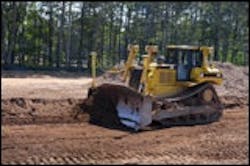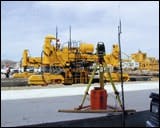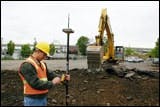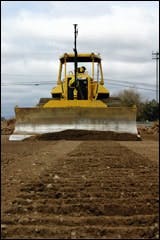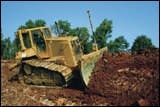Profits Reward Contractors Who Adapt to 3D Grade Controls
Despite some real challenges to using three-dimensional (3D) grade controls that allow the global positioning system (GPS) to guide an earthmover's blade, early adopters of the technology are being rewarded for adapting their businesses with rising profit margins.
Caterpillar greased the skids for adoption of the technology early in 2004 when its joint venture with Trimble announced availability of AccuGrade. Electronic grade controls shifted from being strictly an aftermarket product into the role as a manufacturer-installed option. Grade control could now be easily purchased — and financed — along with the machine. Komatsu has subsequently drawn a supply agreement with Topcon. Deere is taking a different tack, and should soon begin selling machines wired to support either Trimble or Topcon grade-control hardware.
At present, it's probably easiest to cash in on electronic-grade-control's benefits on commercial and residential development projects, where a contractor can often forego most grade stakes without alarming the project owner. Acceptance of the technology in public infrastructure work such as road building lags a bit, but word of the quality and speed of grade-control-assisted earthwork is traveling swiftly among engineers. And GOMACO's success with Leica's automatic grade control is proving lasers on robotic total stations can deliver accuracy adequate for concrete paving faster than string lines.
Fine grade control, whether it uses GPS with laser augmentation or lasers and total stations, whether it controls the machine's blade automatically or simply indicates to the operator how to position the blade, requires project plans converted into 3D digital models. The design community is organized around providing plan sets — either on paper or 2D digital files. So somebody has to build 3D models to drive grade controls.
It's a hurdle that has proven to be worth overcoming.
"Terramodel is a fairly easy program to work with," says Bill Hartley, head of surveying at Delaney Construction in Albany, N.Y. A little bit of training from a programming provider helped him get comfortable with the 3D modeling software quickly. "Most people should be able to pick it up in a couple days.
"And using Trimble's Sitevision Office program, you can drive the virtual project with a dozer on screen to check it. Anything that isn't right — holes in the model or surfaces that aren't smooth — stands out pretty clearly."
Hartley has been using the system on everything from commercial development to landfills and airport taxiways since 2001. He says the most complex conversions can require up to two days to complete a digital-terrain model.
"Before I could pull the trigger on buying the systems, I had to make sure I was able to design a road and load the model on the dozer's grade control," says Russ Chrisman, owner of RC Excavating near Green Bay, Wis. "Our Trimble rep sent me a 45-day trial version of the Terramodel software and a 52-page PowerPoint that described how to get started."
Chrisman learned in the evenings of a couple of weeks how to translate two-dimensional plans into digital 3D models.
"In a week I was feeling pretty good about the system. In two weeks I was ready to place an order. It really was easier than I thought it would be."
Chrisman launched his business four seasons ago with two dozers and an excavator, taking the first year to track time spent handling grade stakes.
"In the first year, the three of us had 892 hours out of the machines setting stakes," Chrisman says. Then he outfitted the dozers with SiteVision. "Now we've got under 100 hours per year invested in staking."
Breaking dependence on grade stakes has benefits beyond saving staking time. Electronic grade controls put an entire project's model in the memory of a computer in the machine's cab. It gives operators lots of options.
"What you're doing with the technology is really empowering the whole team," says Dennis Batye grade manager for site-prep firm, Top Grade Construction in the San Francisco Bay area. "They all feel like part of the team. They have all the data they need to do good work. If they run into a problem on one part of the site, they can go out and find other work to do."
In concrete paving, where exacting grade requirements replace GPS grade control with lasers and total stations, there are many advantages to having the entire site plan digitized and stored in the computer on a trimmer or paver. A.S. Horner measured the benefits while replacing 120,000 cubic yards of aprons around three large hangars at Kirtland Air Force Base in Albuquerque. They used a stringless 3D control system developed by GOMACO and Leica on both the trimmer and the paver.
"The trimming aspect is great. We save a lot of time moving the trimmer from one lane to the other. As soon as we're done trimming, we just select the next lane in the program and we're good to go," says Steve Melton, the contractor's PCCP paving superintendent. "We don't have to deal with jumping over or resetting stringline or making sure we're at grade. The machine and computer tell us exactly where we're at and how far we need to go to get where we need to be."
The paver grade control relies on three total stations, in this case set up 328 feet apart along the length of each pour. Two prisms on the paver are the tracking targets for the total stations.
As the paver moves, it is constantly being tracked by the total stations and information is relayed back and forth between the total stations and the controller on the paver by radio signals a rate of up to eight times per second. In milliseconds, the controller takes real-time coordinate data and compares it to the design plan. The paver controller uses this information to guide the paver and control its grade.
Before the paver passed beyond one total station's laser range, control would leap frog to the next total station. The paver only pauses slightly in these transitions.
"You shoot your total stations into position before the switch is made and you're good to go," Melton said. "The new station takes over for the last one and just keeps right on tracking the paver."
The stringless system achieves the smoothness requirements for the apron pavements, and sets up in about a third of the time as stringlines. With time savings like these, A.S. Horner averaged about 1,200 cubic yards per day in full-production mode.
Users warn that grade-control investments will fail if people in the field don't use the technology correctly. For example, GPS grade-control accuracy improves as the controller receives signals from more satellites. Systems display a scale that indicates grade accuracy, much like the bars that show cell-phone signal strength. Chrisman says, "you can wind up with a real mess on your hands if the accuracies get too far out and the operator thinks, 'it's good enough,' and keeps right on working."
Chrisman was able to hand-pick the few operators for his small company, and he touts their eagerness to learn the systems. In a larger construction firm, success can be determined by how well managers help users appreciate the significance of the technology placed in their hands.
"We named the guys who are using our systems the 3D Grade Control Team and got them matching jackets," says Batye.
"You have to choose the people involved with your 3D grade-control systems carefully," Batye warns. "You need highly motivated people who want to make the program work at all costs. If the people aren't properly motivated, as soon as there's any little problem they will shut it [grade controls] down, and your program is sunk."
Batye suggests that there's a risk involved in taking 3D grade controls to your best operator. Any employee is likely to accept the technology, even if they don't really want it, because managers are making such a fuss. But, Batye says, really good operators are also most likely to shut the system down at the slightest problem. They can cut the grade without it.
"People using the system need to understand the construction process," Batye says. "But they probably shouldn't be your best operators."
This isn't to say that your best operator can't be made a believer.
"We spent a long time researching GPS machine control," says Bob Sweeney, president of Sweeney Excavation in Hamden, Conn. "So I took several key people to ConExpo 1999 and 2002 to have them learn first hand about the latest Trimble technology and to create some buy in.
"I have a senior operator who I respect a lot. I really wanted to get him on board."
"To be honest, I wasn't really thrilled about learning a new way to grade," says Dave McKosky, Sweeney's senior operator. "It's something I've been doing longer than many of my younger co-workers have been alive."
To ease the veteran operator's mind, Sweeney staked the first couple of jobs on which he asked McKosky to use the grade controls. McKosky would grade a stretch, then climb down to measure it. Before long he was operating the system with his usual professionalism.
Sweeney knew he had made a convert when McKosky called him and said, "I've got to tell you this is amazing. This catch basin is .687 low — not .6 — it's .687!"
GPS is changing workers' jobs. Project superintendents have relied on grade checkers and surveyors to measure work progress. But now superintendents can carry GPS rovers or mount them in their pickups. The rover displays whether any surface underfoot is high, low or on grade.
Digital grade control has made an earthmoving-management team out of foreman/surveyor Dave Kruskamp and operator Leroy Brechtelsbauer at Fisher Contracting in Midland, Mich.
Kruskamp traded tapes, rods and transits, for Topcon's HiPer+ GPS receiver. He creates point files for layout and 3D surface models for the dozer controls using Topcon's Office-3D.
Brechtelsbauer can crawl the site with his bulldozer after a day's work to measure elevations.
"He can e-mail the file to me and I can figure the amount he's removed or how much he has to go on my laptop computer or right on my rover with Topcon's Pocket-3D." Kruskamp says.
When scraper and excavator operators need guidance, Brechtelsbauer runs his dozer over their work areas to see if they're above, at, or below grade. This saves the time and expense of having Kruskamp come to the site.
"If we don't have anyone on the job to do layout, I can set stakes off a corner to give the earthmoving crew an idea of where they have to go and what they have to do," says Brechtelsbauer. "It saves a lot of time for everybody and gives us a lot more accuracy."
Being able to measure elevations easily can be worth even more than improved productivity, though. Automated GPS grade control enables Kerr Contractors, a Woodburn, Ore., sitework firm, to practice a business philosophy centered on identifying problems at a project's outset. When the firm started work on a Lowe's and Target site, for example, owner Brent Kerr checked existing grades with a Topcon rover.
"We were there the first two days and figured out with our GPS that the site is a half a foot to a foot higher than what the plans show," says Kerr. "The job was originally an import job, now it's an export job. It was 40,000 cubic yards of import, now it's 70,000 yards of export."
Taking positive steps to discover and resolve these issues at startup is improving the contractor's relationship with owners.
"It helps create another level of trust and dependability where they're depending on us," Kerr said. He follows early consultation with monthly progress reports showing earthwork quantities. "We're considered an equal player — the mainstay."
Grade-control systems are even expanding some contractors' scope of business. Top Grade Construction, for example, wasn't into big earthmoving projects before the firm started investing in grade-control systems. But they had a motor grader and soil compactor. When the firm started using an automatic total station for 3D grade control, Batye realized it was carrying them to a level of productivity and quality that could make the company competitive on larger earthmoving projects. He wrote a business plan that included buying 627 scrapers and going after jobs in the million-cubic-yard range.
"That's just underneath the big-iron jobs," says Batye. "We're not going to take a 10-million yard job from the big dogs like Granite, De Silva Gates, or Independent, but we can take a million-cubic-yard job from them. We're competitive because of the technology."
Automated grade-control users are also finding that the systems ease the strain of hiring productive operators. For example, Stanley Construction in Huntsville, Ala., uses Topcon's System Five 3D-GPS+ on the company's Cat D6 dozers. Working in the field and training new operators, Al Stanley, vice president of project management, is seeing GPS make his new operators proficient and his experienced operators more productive.
"Operators can actually see what they have to do," Stanley explains. "They can see the slopes they are working on. They can see cuts and fills.
"What I've found with operators is if you can't picture it in your mind, you really can't fix it. If you can't picture a 3:1 slope or a ditch line, there's no way that you can grade one.
"GPS puts that picture, that visual image, right in front of the operator in real-time so that as he moves, he sees that image. He sees the slope and how his blade is oriented in relation to it. He's no longer dependent on his experience to be able to translate what that stake says."
Batye's Top Grade Construction has spent $2.5 to $3 million on 3D grade-control technology in the past four years. Hartley tries to add a 3D unit to the Delaney fleet each year, depending on the type and size of jobs coming in. Chrisman equipped his first two machines with an initial investment of about $150,000, and he didn't hesitate to put 3D grade control on a third dozer. He's considering adding GPS to his excavator.
All of these firms, and names such as American Infrastructure, McAninch, and Sukut, are investing to expand use of electronic grade controls because the systems work. They're overcoming the challenges because there is more money to be made with the technology than without.
